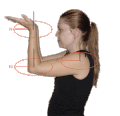Eshkol-Wachman movement notation
The system was created in Israel by dance theorist Noa Eshkol and Avraham Wachman, a professor of architecture at the Technion.
[1] The system is used in many fields, including dance, physical therapy, animal behavior and early diagnosis of autism.
Positions of the free end of the segment can be defined by two coordinate values on the surface of that sphere, analogous to latitude and longitude on a globe.
These two numbers are enclosed in brackets or parentheses to indicate whether the position in being described relative to an adjacent limb or to external reference points, such as a stage.
Its user therefore can write down any form of human or animal movement without limiting oneself to any particular style (classical ballet for example).
(When performed without music, the audience and the dancers are forced to focus on how movement by itself can evoke emotions within and set the mood of a choreographed dance.)
The use of movement notation can also lead to the discovery of new laws of composition in particular dance styles, similar to those found in music or other types of art where aesthetic rules are implemented.
Movements are written on a horizontally ruled notation page (resembling a spreadsheet) which represents the body.
[13] It was used in the field of graphic and kinetic visual art,[14] and a computer system has been written to plot any movement that can be recorded in EWMN.
It shows that specific movement patterns appearing in the first few months of life can be a reliable predictor of the later development of Autism and Asperger's Syndrome.
Notated record of studies in animal behavior carried out by Dr. Ilan Golani at the Zoology Department, Tel Aviv University.
Pellis, S. M. A description of social play by the Australian magpie gymnorhina tibicen based on Eshkol-Wachman notation.
3:61–79; 1981 Pellis, S. M. An analysis of courtship and mating in the Cape Barren goose Cereopsis novaehollandiae latham based on Eshkol-Wachman movement notation.
Pellis, S. M. Development of head and foot coordination in the Australian Magpie gymnorhina tibicen, and the function of play.
Pellis, S. M.; Officer, R. C. E. An analysis of some predatory behaviour patterns in four species of carnivorous marsupials (Dasyuridae), with comparative notes on the eutherian cat Felis catus.
Superiority and inferiority: A morphological analysis of free and stimulus bounds behavior in honey badger (Mellivora capensis) interactions.
Teitelbaum, P.; Pellis, S. M., DeVietti, T. L. Disintegration into stereotypy induced by drugs or brain damage: A micro-descriptive behavioral analysis.
Whishaw, I. Q.; Pellis, S. M. The structure of skilled forelimb reaching in the rat: A proximally driven stereotyped movement with a single rotatory component.
Whishaw, I. Q.; Pellis, S. M., Gorny, B. P. Skilled reaching in rats and humans: Evidence for parallel development or homology.
Whishaw, I. Q.; Dringenberg, H. C., Pellis, S. M. Forelimb use in free feeding by rats: Motor cortex aids limb and digit positioning.
Whishaw, I. Q.; Pellis, S. M., Gorny, B. P. Medial frontal cortex lesions impair the aiming component of rat reaching.
Whishaw, I. Q.; Pellis, S. M., Gorny, B., Kolb, B., Tetzlaff, W. Proximal and distal impairments in rat forelimb use in reaching following pyramidal tract lesions.
Whishaw, I. Q.; Gorny, B., Tran-Nguyen, L. T. L., Castañeda, E., Miklyaeva, E. I., Pellis, S. M. Doing two things at once: Impairments in movement and posture underlie the adult skilled reaching deficit of neonatally dopamine-depleted rats.
Field, E. F.; Whishaw, I. Q., Pellis, S. M. An analysis of sex differences in the movement patterns used during the food wrenching and dodging paradigm.
Skilled movements in prey catching and in reaching by rats (Rattus norvegicus ) and opossums (Monodelphis domestica ): Relations to anatomical differences in motor systems.
Field, E. F.; Whishaw, I. Q., Pellis, S. M. The organization of sex-typical patterns of defense during food protection in the rat: The role of the opponent's sex.
Field, E. F.; Whishaw, I. Q., Pellis, S. M. A kinematic analysis of sex-typical movement patterns used during evasive dodging to protect a food item: The role of gonadal androgens.
89:167–177; 1998 Whishaw, I. Q.; Sarna, J., Pellis, S. M. Evidence for rodent-common and species-typical limb and digit use in eating derived from a comparative analysis of ten rodent species.
Pasztor, T. J.; Smith, L. K., MacDonald, N. L., Michener, G. R., Pellis, S. M. Sexual and aggressive play fighting of sibling Richardson's ground squirrels.
Whishaw, I. Q.; Suchowersky, O., Davis, L., Sarna, J., Metz, G. A., Pellis, S. M. A qualitative analysis of reaching-to-grasp movements in human Parkinson's disease (PD) reveals impairments in coordination and rotational movements of pronation and supination: a comparison to deficits in animal models of PD.








